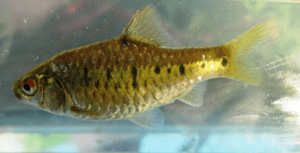Gold barb facts for kids
The Chinese barb (Barbodes semifasciolatus) is a type of fish that lives in fresh water. It belongs to the cyprinid family, which includes carps and minnows. You can find these fish naturally in the Red River area in Southeast Asia, usually in water that is about 5 meters (16 feet) deep or less. A special kind of Chinese barb, called the gold barb or Schuberti barb, is very popular to keep in aquariums.
Quick facts for kids Chinese barb |
|
|---|---|
 |
|
| Conservation status | |
| Scientific classification | |
| Synonyms | |
|
Barbus aureus Tirant, 1883 (Ambiguous) |
Contents
What Chinese Barbs Look Like
Adult Chinese barbs have backs that curve quite a bit. They also have a short pair of whiskers, called barbels, near their mouths. These barbels are on the upper jaw, at the corners of their mouth.
Their backs are light to reddish-brown. The sides of their bodies are a shiny metallic green or yellow-green. They often have a golden glow underneath. Their bellies are usually whitish. During mating season, male barbs have yellow-green bellies. Female barbs are usually duller in color and look a bit bigger overall.
These fish can grow up to about 7 centimeters (2.8 inches) long. However, most Chinese barbs are smaller, around 3.5 centimeters (1.4 inches) long.
What Chinese Barbs Eat
Chinese barbs eat a variety of foods. Their diet includes small invertebrates. These are creatures without a backbone, like insects, crustaceans (such as tiny shrimp), and worms. They also eat different kinds of plant matter.
Reproduction and Life Cycle
Chinese barbs are known as "egg-scatterers." This means they release their eggs freely into the water. Adult barbs usually lay around 100 eggs at one time. However, some females have been seen laying as many as 400 eggs! This egg-laying, or spawning, usually happens early in the morning, right when the sun comes up.
Chinese Barbs in Aquariums
The gold barb is a very popular type of Chinese barb for aquariums. It's also known as the Schuberti barb. This special golden version was created by a fish hobbyist named Thomas Schubert in the 1960s. He used selective breeding to develop its unique color. For many years, people thought the gold barb was a different species. But it's actually just a specially bred version of the original green Chinese barb. The green type is rarely seen in aquariums.
Gold barbs are active fish that like to swim in groups. They can be a little bit aggressive, but usually in a mild way. They spend most of their time swimming in the middle and bottom parts of the aquarium. In an aquarium, a gold barb typically lives for about four to six years. Many fish keepers like to include gold barbs in their community tanks. These are tanks with many different types of fish living together.
Gold barbs can easily breed in outdoor pools and ponds during the summer. They can also handle cooler temperatures better than some other tropical fish. However, they don't do as well in the cold as their original, plainer Chinese barb relatives.
Over the years, different colors of gold barbs have appeared. In the 1970s, Dennis Wilcox created albino gold barbs in the US. Around the same time, Stanislav Frank saw gold barbs in Europe that had no black markings. By the 1990s, pink-colored barbs started to appear. More recently, barbs with three colors – black, yellow, and pink – have been seen.
In an aquarium, gold barbs will happily eat flake food. They also benefit from eating live foods sometimes. Good live food options include mosquito larvae or daphnia.
Gallery
See also
- List of freshwater aquarium fish species






